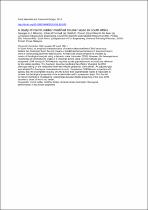JavaScript is disabled for your browser. Some features of this site may not work without it.
- ResearchSpace
- →
- Research Publications/Outputs
- →
- Journal Articles
- →
- View Item
| dc.contributor.author |
Mturi, George AJ

|
|
| dc.contributor.author |
O'Connell, Johannes S

|
|
| dc.contributor.author |
Zoorob, SE

|
|
| dc.contributor.author |
De Beer, Morris

|
|
| dc.date.accessioned | 2015-03-12T09:31:11Z | |
| dc.date.available | 2015-03-12T09:31:11Z | |
| dc.date.issued | 2014-05 | |
| dc.identifier.citation | Mturi, G.A.J, O’Connell, J., Zoorob, S.E. and De Beer, M. 2014. A study of crumb rubber modified bitumen used in South Africa. Road Materials and Pavement Design, vol.15(4), pp 774-790 | en_US |
| dc.identifier.issn | 1468-0629 | |
| dc.identifier.uri | http://www.tandfonline.com/doi/pdf/10.1080/14680629.2014.910130 | |
| dc.identifier.uri | http://hdl.handle.net/10204/7885 | |
| dc.description | Copyright: 2014 Taylor & Francis. Due to copyright restrictions, the attached PDF file only contains the abstract of the full text item. For access to the full text item, please consult the publisher's website. | en_US |
| dc.description.abstract | In South Africa, an empirical characterisation of crumb rubber modified (CRM) bituminous binders has historically been the only means of predicting their performance in pavement layers, short of constructing pavement test sections. An improved characterisation is provided by means of rheological analysis using a dynamic shear rheometer (DSR). However, the heterogeneous morphology of CRM bitumen makes it a challenge to test using current methods and equipment. DSR testing of CRM bitumen requires a plate gap adjustment to avoid any influence by the rubber particles. This has been done by monitoring the effect of changing the DSR plate gap setting on the measured linear visco-elastic properties of the binder. An adjusted gap was adopted for rheological measurements so as to characterise CRM bitumen properties with ageing. But, the incomplete recovery of CRM binder from asphalt/seals makes it impossible to monitor the rheological properties of the in situ binder within a pavement layer. This has led to indirect methods of investigating relationships between tested properties of the pure CRM bitumen to those of the in situ binder. | |
| dc.language.iso | en | en_US |
| dc.publisher | Taylor & Francis | en_US |
| dc.relation.ispartofseries | Workflow;12970 | |
| dc.subject | Crumb rubber modified binder | en_US |
| dc.subject | Dynamic shear rheometer | en_US |
| dc.subject | Rheological performance | en_US |
| dc.subject | In situ binder properties | en_US |
| dc.title | A study of crumb rubber modified bitumen used in South Africa | en_US |
| dc.type | Article | en_US |
| dc.identifier.apacitation | Mturi, G. A., O'Connell, J. S., Zoorob, S., & De Beer, M. (2014). A study of crumb rubber modified bitumen used in South Africa. http://hdl.handle.net/10204/7885 | en_ZA |
| dc.identifier.chicagocitation | Mturi, George AJ, Johannes S O'Connell, SE Zoorob, and Morris De Beer "A study of crumb rubber modified bitumen used in South Africa." (2014) http://hdl.handle.net/10204/7885 | en_ZA |
| dc.identifier.vancouvercitation | Mturi GA, O'Connell JS, Zoorob S, De Beer M. A study of crumb rubber modified bitumen used in South Africa. 2014; http://hdl.handle.net/10204/7885. | en_ZA |
| dc.identifier.ris | TY - Article AU - Mturi, George AJ AU - O'Connell, Johannes S AU - Zoorob, SE AU - De Beer, Morris AB - In South Africa, an empirical characterisation of crumb rubber modified (CRM) bituminous binders has historically been the only means of predicting their performance in pavement layers, short of constructing pavement test sections. An improved characterisation is provided by means of rheological analysis using a dynamic shear rheometer (DSR). However, the heterogeneous morphology of CRM bitumen makes it a challenge to test using current methods and equipment. DSR testing of CRM bitumen requires a plate gap adjustment to avoid any influence by the rubber particles. This has been done by monitoring the effect of changing the DSR plate gap setting on the measured linear visco-elastic properties of the binder. An adjusted gap was adopted for rheological measurements so as to characterise CRM bitumen properties with ageing. But, the incomplete recovery of CRM binder from asphalt/seals makes it impossible to monitor the rheological properties of the in situ binder within a pavement layer. This has led to indirect methods of investigating relationships between tested properties of the pure CRM bitumen to those of the in situ binder. DA - 2014-05 DB - ResearchSpace DP - CSIR KW - Crumb rubber modified binder KW - Dynamic shear rheometer KW - Rheological performance KW - In situ binder properties LK - https://researchspace.csir.co.za PY - 2014 SM - 1468-0629 T1 - A study of crumb rubber modified bitumen used in South Africa TI - A study of crumb rubber modified bitumen used in South Africa UR - http://hdl.handle.net/10204/7885 ER - | en_ZA |






